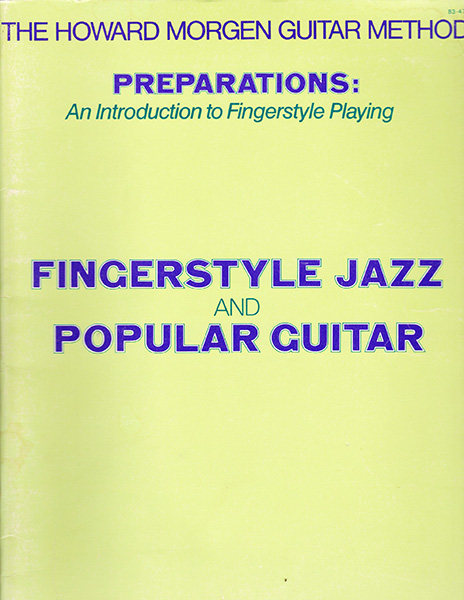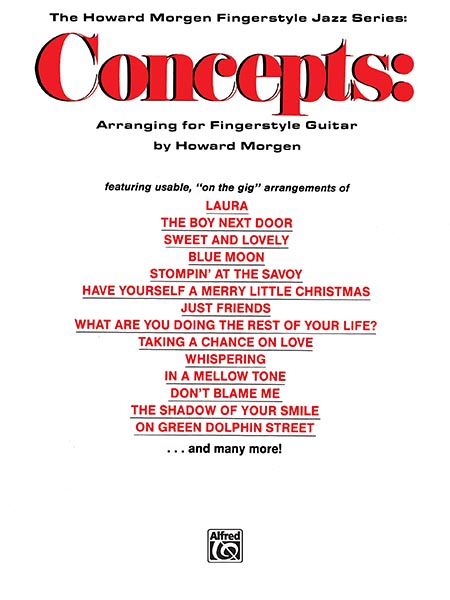Table of Contents
Book Review: Howard Morgen’s “Concepts”
While the west coast had Ted Greene, for those of us on the east coast, we had Howard Morgen. Both were brilliant musicians/authors and have each have left books that are essential to the serious guitarist. For Fingerstyle guitarists, “Concepts” is considered by many, an essential book to study.
Background
I started studying with Howard in the early mid-80’s and “Concepts” was still a fairly new book. Needless to say, it was very inspiring to study with the man who wrote the book. Howard was well known for having many of the top guitarists in the tri-state area studying with him. While I was studying with him he started to travel into Manhattan to teach Paul Simon – the only time he left his studio to teach a student.
“Concepts” contains many of Howard’s arranging techniques and concepts that use Jazz and Popular songs as a vehicle to meld them into the practitioner’s playing.

Preparations
“Preparations” was the first book that I had seen by Howard Morgen, as a friend of mine was studying out of it. Since I had already started to learn how to play Classical guitar, I thought that the material was a bit too basic for my needs, and thus looked into starting with “Concepts” instead.
“Preperation” provides a basic foundation for the playing of Fingerstyle Jazz, as well as Popular Guitar. Players who are not accustomed to Fingerstyle playing will find much of the instruction to be interesting, however, if you have a basic understanding of the techniques or have dabbled in Classical guitar, you can skip this one and jump into the follow up book, “Concepts”.
What I remember most about this book was a musical example of “Sing, Sing, Sing”, which was my father’s favorite song, so at the time I felt the need to learn it.
While not a bad book, it does pale in comparison to “Concepts”. “Preparations” is currently out of print.

Concepts
The front and back covers of my original copy of “Concepts”, with the plastic spiral binding, have torn off and served as bookmarks for when I worked in the book. There’s a lot of great information contained within and I still like to take it out occasionally and play through some of the pieces. There’s a reason why many colleges and universities adopted this book for their guitar curriculums.
Table of Contents
The first interesting thing that you encounter is the Table of Contents. What makes this unique is that each page is divided vertically down the middle, with the left side of the page feature the songs and their associated page numbers and the right hand side features the Resources, Theory and Exercises, with their corresponding page numbers. This format is great for picking a specific concept and then being able to move to that section and either work on the songs or the exercises/theory that go with them.
Example: page 75 on the left side has the song, “The Green Leaves of Summer” and on the right, it has page 74, The Cycle, which introduces the Cycle of Fifths.
Independence between the Thumb and Fingers
Although only three pages, these studies take basic syncopations and introduce them over a bass note using only open strings so that the student can become accustomed to the technique, without having to be concerned about left hand fingerings. Intermediate to advanced students can possibly skip over this section, but it is quite useful for starting this technique.
Conceptual Approach
Each “section” of the book is organized in the same manner. There are songs, lesson text, exercises and a box containing “Supplementary Suggestions”. The “Supplementary Suggesions” box indicates the end of the section and provides the reader with a list of books that are suitable for studying along with the previous material in this section. The downside is that this was published in 1982, so forty years later, some of the recommendations are no longer in print.
Songs
There are a lot of great songs included within the book, as well as a wide range of styles. Some of my favorites to play were: “Just Friends”, “What Are You Doing the Rest of Your Life”, “Taking a Chance on Love” and “Have Yourself a Merry Little Christmas”.
Not surprisingly, the songs become more “complex” as the book progresses. There are some challenging pieces scattered throughout, but the focus is on songs that are playable, so that the arranging concepts can be understood.
Overview
I tend to view the book as having two main topics: Bass Lines and Chord Melody. Each of these topics have several subtopics associated with them.
Example: The topic of Bass Lines include: Rhythmic Devices, Walking Bass Lines, Choosing Notes for Bass Lines and Tonal Elements in a Bass Line. Each of these contain important concepts that are explored by means of text, examples, exercises and songs.
The topic of Chord Melody can be considered to be the real “meat” of the book and a lot of the theory oriented texts are contained here. This includes subjects such as, The Cycle, Reharmonization, The Cycle and Bass Lines, Three Against Two, Rhythmic Devices for Latin Music, Low D Tuning, Artificial Harmonics, etc.
Appendix
The Appendix section features a lot of interesting topics and will prove to be quite useful for players below the advanced level. The topics include: Slurred Notes with Bass Notes, Intervals, Solo Guitar Keys, How to Transpose a Melody Using the Staff, Finding Moving Lines with Chord Symbols, Scales in 10ths, Right Hand Harmonic Technique and more. Each of the topics are briefly dealt with and is a good introduction for those unfamiliar with the specific subject matter.
Like all of the previous sections of the book, the appendix also includes a Supplementary Suggestions box. This box contains many excellent books, many of which are still in print. This page also features an Artist List of many outstanding Fingerstyle artists. Another nice feature is that this is further expanded upon by grouping artists under the heading of a specific technique that they are known for. This is a great list for players who can use YouTube to see videos of these masters in action.
Cassette
For the “completist”, it should be known that there was a cassette available of Howard performing various pieces within the book.
However, Howard HATED the recording, as it was done in a somewhat dubious manner. He told me that they quickly ran through the pieces to set recording levels and such. But, these initial run-throughs are what were eventually released and he never had the opportunity to play the pieces the way he envisioned them. He was not happy with the experience and told everyone not to buy the tape. I have a copy of the tape and it’s by no means “terrible”, but, the recording doesn’t capture his tone or musicality in a way that his students would have been accustomed to.
http://www.howardmorgen.com/index.html
Summary
At the time that this book came out, there was nothing else quite like it. It’s no surprise that many colleges quickly added it to their guitar programs. Like many great teachers, Howard Morgen knew that teaching is a communication skill and here he clearly divulges the pertinent information for aspiring guitarists who want to enter the world of Contrapuntal Fingerstyle guitar, as well as the beauty of Chord Melody.
One of the striking things about Howard’s arrangements is that they are not filled with “needless” notes, or overly complex voicings, for the sake of “showing off”, but, the lines are concise and very musical. I don’t know anyone who has heard one of the songs in the book and not remarked on how musical they sounded.
Howard’s desk was full of “works in progress” for an upcoming book and he would occasionally take one out and show me how things were coming along and the decision processes that were used to get there. It was clear how much time and effort he was putting into the material, while at the same time making sure that it was accessible to aspiring players.
The layout of the book and the material presented are conducive to progressive study for the serious student. Each step of the way, new concepts are introduced and interjected into the songs so that the student becomes more confident in their comprehension, while at the same time learning live long lessons that will influence their musicality for the rest of their life.
While the material can certainly be practiced on your own, it would be quite beneficial to study with a teacher who can really help explain and build upon the theoretical subject matter. This is especially true if you choose to use some of the additional books from the Supplementary Suggestions.
One of the surprises of the book is that quality of the songs chosen. For the most part, the overwhelming majority of songs are suitable for playing in a solo setting and would work well in either a restaurant setting or for a solo guitar concert.
Another point of interest is the use of open strings throughout the compositions. This adds a nice “continuity” to the songs, as parts flow seamlessly from part to part.
Weighing in at 188 pages, there is a ton of information contained within these pages and there’s no doubt that you can obtain serious results, if you are determined to work hard throughout the book – both from a technical and theoretical point of view.
I have a copy of his last book, “Through Chord-Melody and Beyond” and I am looking forward to working through it and reviewing it at some point in the future.
Highly Recommended
Final Words
I’d like to take a moment to thank everyone who has purchased my book! I appreciate your interest and support!
Good news! “Contrapuntal Improvisation” will be on sale for the entire month of March. If you’ve been considering it, this may be a good time to do so. Unfortunately, the non-USA postage is still ridiculous… even with me subsidizing part of it… 🙁





0 Comments